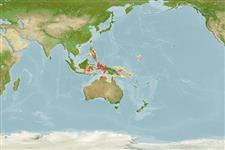Common names from other countries
Klassifizierung / Names
Namen | Synonyme | Catalog of Fishes(Gattung, Arten) | ITIS | CoL | WoRMS | Cloffa
>
Anguilliformes (Eels and morays) >
Congridae (Conger and garden eels) > Heterocongrinae
Etymology: Heteroconger: Greek, heteros = other + Latin, conger = conger (Ref. 45335); mercyae: Named for Mercy Paine, who discovered the eel colony and helped us collect the type specimens..
Environment: milieu / climate zone / depth range / distribution range
Ökologie
seewasser riff-verbunden; tiefenbereich 4 - 10 m (Ref. 90102). Tropical
Western Pacific: Philippines, Indonesia (Kaiman, West Papua), but likely to occur as far east as Rabaul, New Britain (based on an underwater photo).
Size / Gewicht / Alter
Maturity: Lm ? range ? - ? cm
Max length : 67.8 cm TL Männchen/unbestimmt; (Ref. 82435)
Kurzbeschreibung
Morphologie | Morphometrie
Rückenflossenweichstrahlen (insgesamt): 578-629; Afterflossenweichstrahlen: 390 - 432; Wirbelzahl: 204 - 213. This relatively slender species has the following distinct set of characters: dorsal-fin origin anterior to gill opening; with pterygoid teeth; body depth at gill opening 28.8-35.2% of HL; preanal vertebrae 62-71 (mean = 65), total vertebrae 204-213 (mean 207.4) ; preanal lateral-line
pores 63-69; body colouration consisting of zebra-like black and white barring on head grading to complex black and white maze pattern on body (Ref. 82435).
Collected from a single colony, occupying about 100 sq. m with approximately 50 eels at 5-6 m depth. The bottom is fine, silty sand and influenced by a freshwater stream along the adjacent shoreline, about 100 m distance, with the nearest reef formation about 50 m from the site (Ref. 82435).
Life cycle and mating behavior
Geschlechtsreife | Fortpflanzung | Ablaichen | Eier | Fecundity | Larven
Allen, G.R. and M.V. Erdmann, 2009. Heteroconger mercyae, a new species of garden eel (Congridae: Heterocongrinae) from West Papua, Indonesia. aqua, Int. J. Ichthyol. 15(3):135-142. (Ref. 82435)
IUCN Rote Liste Status (Ref. 130435)
CITES (Ref. 128078)
Not Evaluated
Bedrohung für Menschen
Harmless
Nutzung durch Menschen
Mehr Information
NamenSynonymeMetabolismusRäuberÖkotoxikologieFortpflanzungGeschlechtsreifeAblaichenFecundityEierEientwicklung
Alter/GrößeWachstumLänge-GewichtLänge-LängeLängenhäufigkeitenMorphometrieMorphologieLarvenLarven Pop.Dyn.RekrutierungDichte
ReferenzenAquakulturAquakultur ProfilZuchtlinienGenetikElectrophoresesVererbbarkeitKrankheitenVerarbeitungMass conversion
PartnerBilderStamps, Coins Misc.LauteCiguateraGeschwindigkeitSchwimmstilKiemenoberflächeOtolithsGehirngrößeSehfähigkeit
Tools
Zusatzinformationen
Download XML
Internet Quellen
Estimates based on models
Preferred temperature (Ref.
115969): 28.1 - 29.2, mean 28.8 (based on 246 cells).
Phylogenetic diversity index (Ref.
82804): PD
50 = 0.5000 [Uniqueness, from 0.5 = low to 2.0 = high].
Bayesian length-weight: a=0.00102 (0.00046 - 0.00225), b=3.06 (2.88 - 3.24), in cm Total Length, based on all LWR estimates for this body shape (Ref.
93245).
Trophic level (Ref.
69278): 3.4 ±0.4 se; based on size and trophs of closest relatives
Widerstandsfähigkeit (Ref.
120179): mittel, Verdopplung der Population dauert 1,4 - 4,4 Jahre. (Preliminary K or Fecundity.).
Fishing Vulnerability (Ref.
59153): Moderate to high vulnerability (47 of 100).
